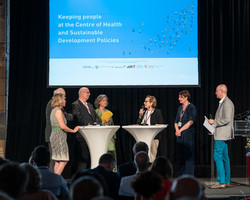A quarter-century of regional health

Peter Mullenberg/Photostique
From its launch in 1993 to the present day, the Regions for Health Network (RHN) has worked towards ensuring that no one is left behind on health matters around Europe.
This year marked the 25th annual meeting of the network with a review of health inequity, progress in achieving the SDGs and preparing the health workforce for the future. It also offered a chance for reflection on the past 25 years in making regions a vital part of health delivery.
“When the network was conceived, it was a special time for public health,” explains Dr Francesco Zambon, the RHN’s Coordinator in Venice. “The Ottawa Charter was endorsed some years earlier and created incredible momentum for shifting the focus from the health of individuals to the health of populations.”
When the RHN was founded, Europe was emerging into a period of change. With greater links being forged between the east and west of the continent, the first preliminary meeting was held in Lugano, Canton Ticino, Switzerland, which then led to the formal foundation document of the RHN agreed in Düsseldorf, Germany. Its first annual meeting was held in Barcelona, Spain.
The early years of the RHN saw innovation and experimentation, not least the twinning of two parts of Europe across a former dividing line and the creation of multiple forms of differing regional groupings.
As Dr Zambon describes, this helped place regions at the centre of delivering health across the WHO European Region: “Health professionals started thinking about how they could work differently, across sectors, involving all levels of governance. At the same time, regions in Europe were becoming more and more important, with considerable devolution of authority from the central level. From these two streams of thought, RHN was born.”
Regional health today
Fast forward a quarter-century, and the RHN is playing a vital role in delivering health across Europe. Now covering 45 regions within 28 countries, the network helps facilitate and advocate for health for all, and develop and implement actions that both promote health and reduce health inequities, while acting as a bridge between national goals and local delivery.
The network also aids its members by collecting and distributing data to and from the regional level while collaborating with other regions to obtain funds at the European Union level.
One region which works closely with RHN is Østfold County. Located in south-eastern Norway, this region used to be highly industrialized and has more health problems than other parts of the country. Professor Camilla Ihlebæk of the Norwegian University of Life Sciences explains the importance of RHN to health in this area: “In Norway, the regional level is very important and the responsibility for public health is delegated to the regions and municipalities. Through participating in the RHN, our region is always updated on current research, best practices and new policies within the field.”
“Membership in a WHO network also helps mobilize awareness and commitment from regional politicians,” she adds. “The RHN acts as an important facilitator for collaboration between regional stakeholders, such as research institutions and local governments.”
One prominent example is RHN’s work with local authorities in Bibione, Italy, to make a popular local beach smoke-free. This was the first initiative of its kind in the country and, following positive public reaction to a survey, the beach introduced measures to promote a healthy lifestyle and physical activity, as well as sustainable tourism and awareness raising about environment and health. RHN documented the process and produced a publication to share experiences and best practices with other local organizations who may be considering similar initiatives.
IMPACT health
Genuinely understanding the work of the RHN requires getting to grips with the IMPACThorama structure, with IMPACT being an acronym that reflects the activities of the network. This framework was created to produce a visual image of what the network does and helps RHN in its work.
The IMPACT element relates to six key themes: Inspire, Mobilize, Practice, Accelerate, Connect and Transform. By following this structure, the RHN provides an umbrella and support for the regions through activities such as: annual meetings and workshops, ensuring that member regions get to know each other; and identifying practice-related work processes and peer-to-peer learning.
Dr Zambon also highlighted how this framework plays a broader role in the delivery of WHO’s 13th General Programme of Work (GPW13): “Another feature of this framework is how it fits perfectly with WHO’s GPW13. Bringing about the triple billion goals [achieving universal health coverage, addressing health emergencies, and promoting healthier populations] will be impossible if we don’t involve those more regional levels of government which are necessarily closer to the people.”
This structure also allows for better communication to accelerate and connect the various regions while contributing to better policy coherence.
Looking forward
As future health challenges come into view, the RHN is set to retain its importance and promote health around the WHO European Region as a whole.
Professor Ihlebæk agrees: “In a fast-changing world with new public health challenges and information overflow, the RHN will be vital for us to keep up with current knowledge and place public health on the regional agenda.”
Since the RHN was founded, there has been a clear pattern in its work: learning together, planning joint activities, and catching up on and reacting to developments in the WHO European Region with the specific perspective of subnational contexts. It is these founding principles of collaboration which are set to consolidate and strengthen the RHN’s work in the future.



